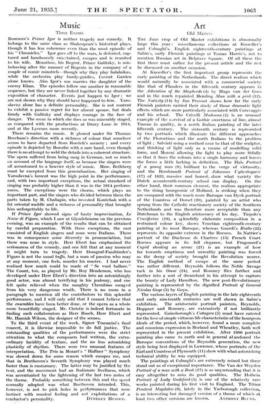Art
Old Masters
THE June crop of Old Master exhibitions is abnormally large this year : miscellaneous collections at Knoedler's
and Colnaghi's, English eighteenth-century paintings at Sabin's, early Flemish paintings at Tomas Harris's, not to mention Russian art in Belgrave Square. Of all these the first three must suffice for the present article and the rest be discussed on another occasion.
At Knoedler's the first important group represents the early painting of the Netherlands. The direct realism which would naturally be associated with a commercial society like that of Flanders in the fifteenth century appears in the Adoration of the Shepherds (4) by Hugo van der Goes and in the much repainted Memling Man with a pink (12).
The Nativity (14) by Jan Provost shows how far the early Flemish painters carried their study of those dramatic light effects which are more particularly associated with Caravaggio and his school. The Crivelli Madonna (2) is an unusual example of the survival of a Gothic sweetness of line, almost Tuscan in quality, in a north Italian painting of the later fifteenth century. The sixteenth century is represented by two portraits which illustrate the different approaches of the Florentines and the north Italians to the problem of light ; Salviati using a method near to that of the sculptor, and thinking of light only as a means of modelling solid form, and Moroni allowing the light to play more fitfully so that it fuses the colours into a single harmony and leaves the forms a little lacking in definition. The Hals Portrait of a young man (8), brilliant to the verge of virtuosity, and - the Rembrandt Portrait of Johannes Uyttenbogaerl (17) of 1633, massive and honest, show what variety the Dutch seventeenth-century school can display. On the other hand, their common element, the realism appropriate to the rising bourgeoisie of Holland, is striking when they are compared with the much more Baroque van Dyck portrait of the Countess of Dorset (20), painted by an artist who sprung from the Catholic reactionary society of the Southern Netherlands and was therefore more acceptable than any
Dutchman to the English aristocracy of his day. Tiepolo's Crucifixion (19), a splendidly elaborate composition in a
restrained colour key, shows Venetian eighteenth-century painting at its most Baroque, whereas Guardi's Rialto (22) represents its opposite extreme in the Rococo. In Nattier's portrait of the Duchesse de Chartres (13) French Court Rococo appears in its full elegance, but Fragonard's Cupid shooting an arrow (21) is an example of how far towards emptiness and unreality painting was forced as the decay of society brought the Revolution nearer. The English method of escape at the same period was rather different. Reynolds follows the Noble Savage tack in his Omai (24), and Romney flies further and further into a sort of dreamland in his attempt to capture the beauty of Lady Hamilton. The new post-Revolutionary painting is represented by the dignified Portrait of General Nicolas Guye (5) by Goya.
The various layers of English painting in the late eighteenth and early nineteenth centuries are well shown in Sabin's exhibition. The aristocratic portrait painters, Reynolds, Hoppner and Romney, are extensively if not brilliantly represented. Gainsborough's Cottagers (5) must have catered for the love of simple virtuous life characteristic of the bourgeois. ideals of the period, which, however, found a more complete and conscious expression in Morland and Wheatley, both well represented in the present exhibition. After 1800 portrait painting also came to earth and in general abandoned the Baroque conventions of the Reynolds generation, the new style being best displayed in Lawrence, whose portraits of the Earl and Countess of Plymouth (11) show with what astonishing technical ability he was equipped.
The paintings at Colnaghi's are extremely mixed but three stand out as of exceptional importance. The Van der Weyden Portrait of a man with a Book (17) is so unpretending that it is easy altogether to miss its good qualities.. The Holbein Portrait of Lady Gudeford (5) is one of the relatively rare works painted during his first visit to England. The Titian Penitent Alagdalen (9), lately in the Yarborough . collection, is an interesting but damaged version of a theme of which at
least two other versions are known. ANTHONY BLUNT.
. . . .








































 Previous page
Previous page